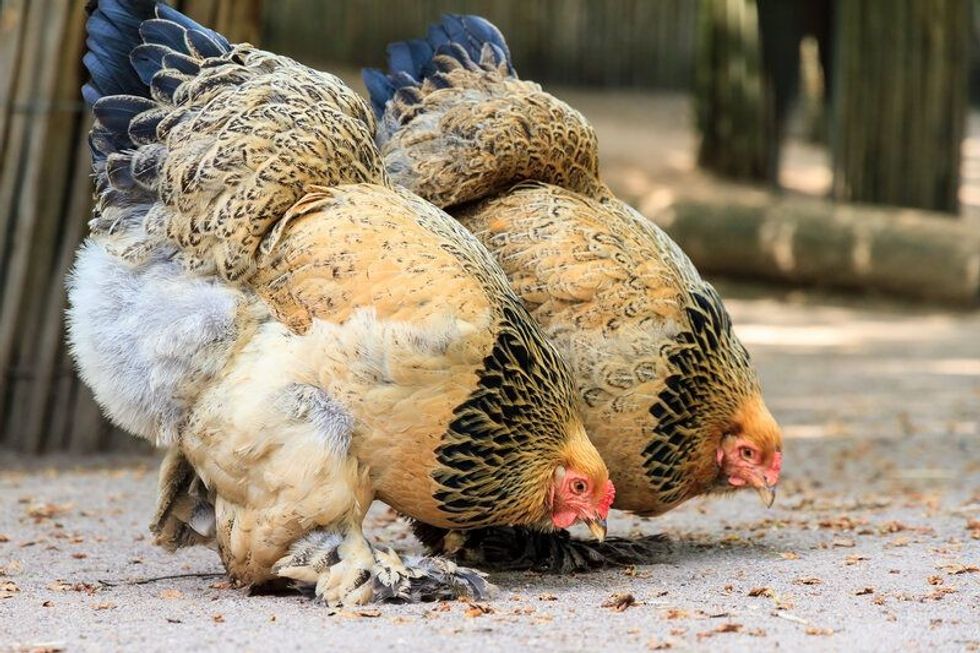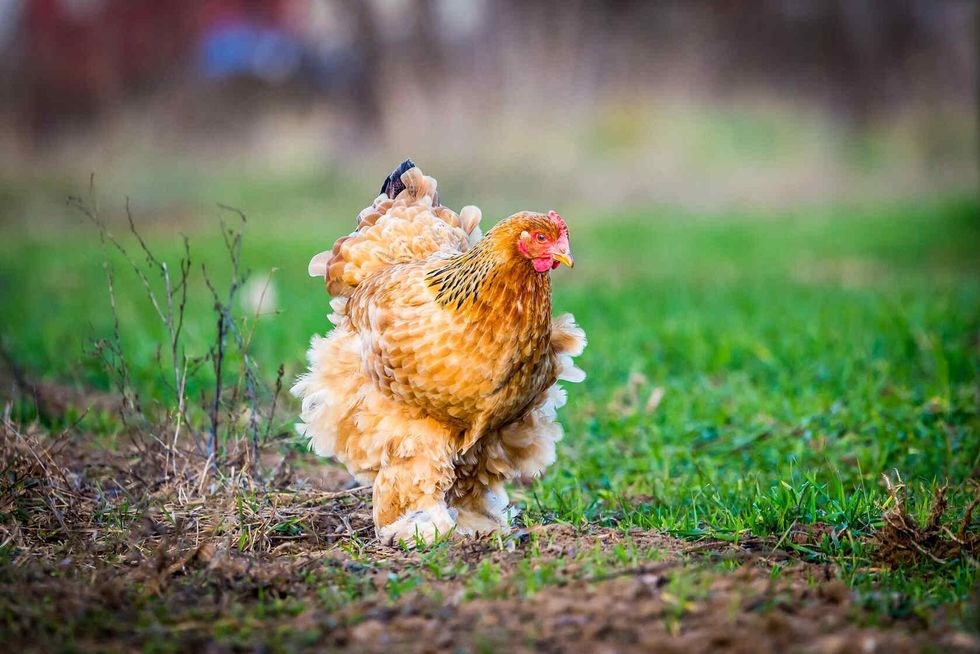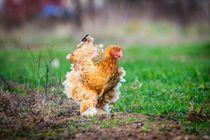Brahma Chicken Size! Comparison Guide To Humans & Other Chickens

A Brahma chicken is a popular poultry bird known for its large size, strength, and vigor.
These large chickens are referred to as the king of poultry because of their large body. The Brahmas along with the Cochin breed of chicken fueled the rise of poultry birds in Britain and America in the 19th century.
There are three accepted varieties of Brahma chickens, they are light Brahma, dark Brahma, and buff Brahma. The buff Brahmas came into the recognition of American poultry culture much later than the light and the dark Brahmas.
The Brahma chickens breed was developed in America by breeding the largest chicken breed of China, the Shanghai fowl and the Chittagong fowls of India. The birds imported from China and India were bred in the United States.
The poultry judges gave the name Bramhaputra to the birds after the Brahmaputra river that flows in India and enters China through its southern borders. Later they came to be known by the short form Brahma.
The chickens get their distinct pea comb like structure from their Indian parents, the Chittagong fowl. Their name was shortened to Brahma and the breed came to be known as Brahma chicken breed in 1854.
The dark Brahma chicken variety was produced commonly in Britain and shipped to America, once they grew in popularity. Until 1930, the Brahma chicken was considered to be a top-tier chicken dish.
They fueled the Hen fever in America and Britain which resulted in the growth of poultry farms around the world. However, following the poultry revolution after 1930 the popularity of the Brahma chicken breed started to fall.
The Brahmas fell from the pecking order because of their slower rate of muscle and size gain.
Different breeds that were more developed and tastier started to fill the table fare and at present, this chicken breed is recognized as a heritage breed by the American Poultry Association and Livestock Conservancy, they are reared by some American backyard chickens.
The Brahmas have thick feathering and heavy down feather layering on their body which makes them more suitable for the cooler climates. This chicken fails to keep its wide body cool in hotter areas.
If you are interested to know more facts about chickens, check out the articles on how are chicken eggs fertilized and chicken egg development facts.
Brahma Chicken Nesting Box Size
The Brahma chicken is a large bird. These big birds were produced by breeding the biggest fowl breed of china and a large chicken breed of India.
The size of these chickens is also bigger than most hens and roosters. They need big open spaces and their nesting boxes should also be bigger in size than the nesting box of an average chicken. The size of the coop plays a significant factor in deciding whether you are eligible to rear these chickens or not.
Being one of the largest chicken breeds of the world, the Brahma chicken needs its size-appropriate nesting coops.
These heavily feathered large chickens cannot be stuffed together in large numbers in small nesting boxes, they need ample space to live freely.
Keeping them in a small nesting box will result in stressing out the birds and will instead, reduce their productivity.
Therefore, before you decide to rear the Brahma chickens, you need to make sure you have enough space to set up large nesting boxes for this breed so that you can fit in the birds. An ideal Brahma chicken coop should be big enough to fit a human inside it.
The average nesting box size of the Brahma chickens and other chicken breeds of similar size is 14 in by 14 in (35.56 cm by 35.56 cm) and 20 in (50.8 cm) in depth, each bird should have four sq ft (1.22 sq m) of space for itself on average inside a coop.
Before rearing these chickens, you also have to ensure that you have a large open space like a garden where they can roam freely for at least a few hours a day.
Overcrowding in the Bramha chicken coop leads to feather picking and several kinds of diseases.
The Bramha chickens are twice the size and weight of the other birds, therefore their nesting boxes should also be bigger in size. A small and uncomfortable nesting box will discourage the birds to lay eggs inside the box.
Brahma Chicken Size And Weight
The Brahma chicken is known for its big size and the generous amount of feather layering makes them look even larger in size. The weight of the Brahma hens is around 10 lb (4.5 kg) while the Brahma roosters weigh around 12 lb (5.5 kg).
They have a sturdy appearance and are often described as proud-looking birds. The thick legs are fully covered with thick layers of feather and feathered feet.
The broad birds appear to stand tall. The Brahma chickens are two times bigger in size than the smaller breeds of chicken.
A Brahma chicken is known all over the world for its size. Only a few breeds of chicken have such huge body sizes, the Brahmas are one of them.
They are a considerably fleshy breed with high meat production but a Brahma hen produces lesser eggs in comparison to the meat production ability of the chicken.
Even though it is a large breed, the size of the birds depends greatly on the breeding methods used for rearing the birds. They are similar in size to the Jersey giant breed.
The Brahma roosters are larger in size than the Brahma hens, however, still, the hens are larger in size than most hens of other breeds. There are three main varieties of Brahma chickens, they are light, dark, and buff.
This bantam variety of the Brahma chicken is the biggest and the most recognized variety of the chicken. The Light Brahma rooster size gives a good estimate of the size of all Brahma roosters.
They are large birds with a wide and deep body and their long body makes a narrow V-shape from the side when they stand on their feathered legs.
They also have a short and strong beak and a pea comb with small wattles. A Brahma rooster is generally larger in size than a Brahma hen.
Even though the birds have such large sizes, they are actually friendly in nature which makes them less intimidating. They have large appetites and as long as they get their treats, they are ready for all the cuddles.
This big bird cannot fly easily because of its size, building a 2-3 ft (0.61-91 m) fence for the Brahams chickens is enough.
Brahma Chicken Egg Size Comparison
Unlike the size of the chickens, the size of their eggs is described as average. The Brahma Chickens have an average egg-laying capacity, the hens lay up to three to four eggs in a single week.
This equates to approximately 150 eggs in a single year. Despite what the size suggests, they are not known to be the most prolific egg layers. Yet, maintaining a small flock of birds in the backyard will still yield a dozen of eggs per week.
The Brahma chicken is a good breed for meat production because of their fleshy body, however, that doesn't make them productive or good egg layers.
The Brahma hen lays medium to large-sized eggs, the average weight of the chicken is measured to be around 2 oz (56 g).
This information proves the fact that a bird that is big in size does not necessarily lay big-sized eggs. A Brahma chicken is one of the largest chicken breeds in the world, they are 66% bigger in size than the standard poultry breeds.
However, the same cannot be said about the size of their eggs, rather their eggs are smaller in size by 17% than an extra-large egg that weighs around 2.2 oz (68 g).
The Brahma chickens lay eggs in the cold weather, they lay eggs throughout the winter season. Their eggs are caramel brown in color.
The hens reach sexual maturity at a slower rate than other standard breeds. This is because this large chicken matures slowly because of its huge size.
Unlike the other breeds of hens that start laying from four months of age, a Brahma chicken will start laying eggs from six to seven months of age.
They lay up to four eggs per week and after two years, their egg-laying capacity naturally declines. The Brahma egg is much smaller in size than the king-size egg that weighs 2.6 oz (73 g).
In the egg comparison chart, the size of their eggs comes after the extra-large egg and before the medium egg weighing 1.7 oz (49 g). Their eggs fall under the moderately large category in the egg comparison chart.

Buff Brahma Chicken Egg Size
A buff Bramha is one of the popular varieties of the Bramha chickens that are native to the parts of the United States having cold climates. They became a part of the American Brahma club in 1800 after being imported from the United Kingdom.
A Brahma chicken is a beginner-friendly breed so you can rear them easily in your backyard. They are reasonable egg layers and lay medium to large-sized eggs.
The buff Brahma chicken is a variety of the Brahma chicken so their eggs have the typical characteristics of a Brahma chicken's egg. They lay beautiful caramel-colored eggs and each bird can lay three to four eggs in a week.
This approximately equates to at least 130-140 Brahma eggs in a year. They are superior winter layers that are an advantage during the winter season.
The eggs are generally large in size with exceptionally large yolks. The large yolks can be used either for cooking or baking.
The Brahma egg production is defined to be moderate, however, their ability to lay in the winter when the other hens stop has made the buff Brahmas a useful chicken. The laying ability of the hen depends on the environment of the nesting box and the food they eat.
Feeding them good quality and nutritious fodder will naturally increase the rate of egg production. If they get proper living conditions in your yard, they will lay throughout the winter when others rest.
Brahma Chicken Rooster Size
A Brahma is a very big chicken breed having heavily layered down and feathered feet. The size of the Brahma rooster exceeds the size of the hen, accordingly, the roosters are heavier than the hens.
Previously a male weighed up to 19 lb (9 kg) but with evolution, their size has also decreased. At present, the weight of a rooster is measured to be 12 lb (5.5 kg).
Apart from their size, a male Brahma chicken can also be separated from the hen by some physical characteristics. Only the roosters have prominent black stripes on their saddle feathers.
The male dark Brahma variety exhibits the greatest physical differences from the females.
A male has a black body in comparison to the gray body of the hen and is often referred to as the black Brahma. Even though their large size can seem intimidating, the roosters are peaceful and docile-natured birds that can live with a flock of birds easily.
Brahma Chicken Size Comparison To Humans
A Brahma chicken is one of the largest chicken breeds in the world. They are not only the largest in size, but they also have a good rate of meat production.
The size of the Brahma chickens is so big that they are even compared to humans. There are many pictures on the internet where we can see a full-grown adult holding the Brahma with two hands and still struggling.
Whereas, commercial poultry owners can hold ordinary chickens on one hand. This comparison solely indicates how gigantic the size of the chicken is.
The size and the weight of the Brahma chickens have decreased a lot from the old times. Previously, the weight of these hefty birds ranged between 13-19 lb (6-9 kg).
The height of the tallest Brahmas is measured to be 30 in (76.2 cm). Most of their weight is because of their heavily feathered body and feathered legs.
A fit and healthy human adult normally weighs six to eight times of this chicken breed and is much taller in size but their weight can be compared easily to the weight of small children. A young child generally weighs a few pounds more than a chicken.
Here at Kidadl, we have carefully created lots of interesting family-friendly facts for everyone to enjoy! If you liked our suggestions for Brahma chicken size then why not take a look at chicken life cycle, or chicken wattle.
We Want Your Photos!
More for You
See All
Bachelor of Arts specializing in English, Master of Arts specializing in English

Rajnandini RoychoudhuryBachelor of Arts specializing in English, Master of Arts specializing in English
With a Master of Arts in English, Rajnandini has pursued her passion for the arts and has become an experienced content writer. She has worked with companies such as Writer's Zone and has had her writing skills recognized by publications such as The Telegraph. Rajnandini is also trilingual and enjoys various hobbies such as music, movies, travel, philanthropy, writing her blog, and reading classic British literature.
Bachelor of Science specializing in Microbiology, Masters of Science specializing in Biotechnology

Pratiti NathBachelor of Science specializing in Microbiology, Masters of Science specializing in Biotechnology
A Master's in Biotechnology from Presidency University and a Bachelor's in Microbiology from Calcutta University. Pratiti holds expertise in writing science and healthcare articles, and their inputs and feedback help writers create insightful content. They have interests in heritage, history, and climate change issues and have written articles for various websites across multiple subjects. Their experience also includes working with eco-friendly startups and climate-related NGOs.
Disclaimer
1) Kidadl is independent and to make our service free to you the reader we are supported by advertising. We hope you love our recommendations for products and services! What we suggest is selected independently by the Kidadl team. If you purchase using the Buy Now button we may earn a small commission. This does not influence our choices. Prices are correct and items are available at the time the article was published but we cannot guarantee that on the time of reading. Please note that Kidadl is a participant in the Amazon Services LLC Associates Program, an affiliate advertising program designed to provide a means for sites to earn advertising fees by advertising and linking to Amazon. We also link to other websites, but are not responsible for their content.
2) At Kidadl, we strive to recommend the very best activities and events. We will always aim to give you accurate information at the date of publication - however, information does change, so it’s important you do your own research, double-check and make the decision that is right for your family. We recognise that not all activities and ideas are appropriate for all children and families or in all circumstances. Our recommended activities are based on age but these are a guide. We recommend that these ideas are used as inspiration, that ideas are undertaken with appropriate adult supervision, and that each adult uses their own discretion and knowledge of their children to consider the safety and suitability. Kidadl cannot accept liability for the execution of these ideas, and parental supervision is advised at all times, as safety is paramount. Anyone using the information provided by Kidadl does so at their own risk and we can not accept liability if things go wrong.
3) Because we are an educational resource, we have quotes and facts about a range of historical and modern figures. We do not endorse the actions of or rhetoric of all the people included in these collections, but we think they are important for growing minds to learn about under the guidance of parents or guardians.







